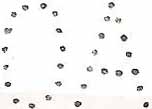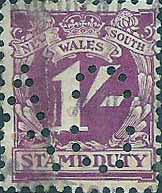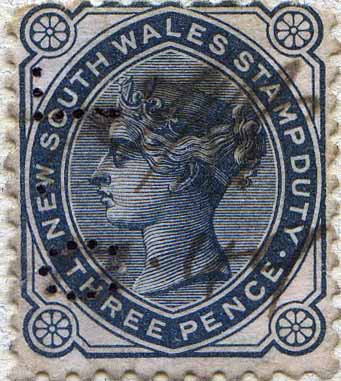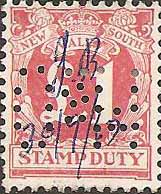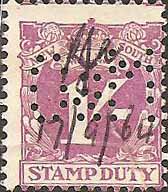|
Private Revenue Perfins of New South Wales An Elsmore Coath production The authors would welcome your comments additions or input into this work A B C D E F G H I J K L M N O P Q R S T U V W Y Other O -------------------------------------------------------- OA.a
User: Ocean Accident Guarantee Corporation Later: Ocean Accident and Guarantee Corporation of Australia Limited
General Insurance provider
Address: Insurance House, 109 Pitt St, Sydney, NSW Revenue Use: Numeral 1929-66 issue 3d, 4d, 6d, 8d, 9d, 1/-, 1/6, 2/-, 2/6, 3/-, 4/-, 5/-, 6/-, 8/- [orange], 8/-[brown], 10/-, £1 Rarity Scale: Numeral 1929-66 issue 3d R4, 4d R3, 6d R3, 8d R3, 9d R3, 1/- R2, 1/6 R2, 2/- R4, 2/6 R2, 3/- R3, 4/- R3, 5/- R3, 6/- R4, 8/- [orange] R4, 8/-[brown] R4, 10/- R4, £1 R4 Background: Ocean, Accident and Guarantee Corporation Limited was established in London, England in 1876 as an branch of the existing Ocean, Railway and General Accident Assurance Co. Ltd. The companies merged in 1890 under the Ocean Accident & Guarantee Corporation name. The company expanded into a broad range of emerging insurance products and created a series of subsidiary companies to match.
The company not only expanded its product range but also its offices and by 1907 it had 32 offices across England and Ireland. International expansion occurred at the same time with offices opened in the USA, South Africa, New Zealand, Canada, China, France, Singapore, Korea, and Australia before 1912. The Australian office was established in Sydney in 1908.
In 1910 the company became a subsidiary of the Commercial Union Assurance Company Ltd, but this did not slow international growth as they opened offices in Holland, Belgium, India, Batavia (now Indonesia), Malaysia, Kenya, Uganda, Egypt and Syria by 1936.
In 1965 Ocean Accident's Irish business was transferred to Hibernian General Insurance Ltd and the company was absorbed and dissolved on 23 December 2005 by the Aviva Group who are the UK’s largest Insurer.
Device: This OA.a device was only used on the revenue stamps of NSW over the period 1936 until about 1961, and given the appearance of pairs of strikes and multiple strikes it is most likely that it was a single die device.
In fact the pattern produced by the OA.a device is rather oversized for the small format NSW Numeral series and as a result you will often find it as a partial strike as well as a partial strike from a pattern intended for an adjacent stamp.
Previous studies of private perfins have featured rather poor images of this pattern. The image in CPA is too small and the image in HAPP is only slightly better. The HAPP image is close to the correct size but the spacing between the letters in wrong suggesting that it was derived from two partial strikes as discussed above.
Related Patterns: Refer to other Ocean, Accident and Guarantee Corporation and related company patterns in:
NSW: AMF.a CU.a CU/A.a CU/&CO.a UAS.a
QLD: Other – Section 1 Commercial Perfins and Cancelling Devices
O.A. & G.C. LTD/ BRISBANE.a -------------------------------------------------------- O.L.a
User: Unknown Revenue Use: QV 1880-1902 issue 3d Rarity Scale: QV 1880-1902 issue 3d R4 Background: Unknown
Device: This OL.a device is found used on the postage stamps of NSW and has only recently been found used on the revenue stamps of NSW as well. The usage is only for a brief period around 1893.
The device appears to be similar to English devices in its structure but as most devices of this time in Australia were of English manufacturer it does not provide fertile ground for study. Given the early nature of the devices usage it was most likely a single die device. Related Patterns: Nil ------------------------------------------------------- O&M.a
User: Charles A. Ord & Minnett.
Stockbrokers
Address: 13-15 O'Connell St, Sydney, NSW. Revenue Use: Numeral 1929-66 issue 3d, 6d, 9d, 1/-, 1/6, 2/-, 2/6, 3/-, 4/-, 5/-, 6/-, 8/-[brown], 10/-, 12/-, 14/-, £1, 30/- Decimal 1966 issue 2c, 4c, 6c, 8c, 20c, 40c, 60c, 90c, $1, $1.60, $1.80, $2, $3 Rarity Scale: Numeral 1929-66 issue 3d R3, 6d R4, 9d R4, 1/- R3, 1/6 R3, 2/- R3, 2/6 R4, 3/- R3, 4/- R3, 5/- R4, 6/- R3, 8/-[brown] R4, 10/- R4, 12/- R4, 14/- R4, £1 R3, 30/- R4 Decimal 1966 issue 2c R4, 4c R2, 6c R4, 8c R3, 20c R3, 40c R4, 60c R4, 90c R4, $1 R3, $1.60 R4, $1.80 R4, $2 R3, $3 R2 Background: Charles Ord left a senior position in the Bank of New South Wales and bought a seat on the Sydney Stock Exchange in 1949 and in 1951 he joined with Jack Minnett to form the broking firm, Ord and Minnett. Charles Ord and Jack Minnett knew each other professionally but there friendship was based mainly on the time they spent together while serving in the Australian Army during World War Two. The next three decades saw the business grow steadily, initially through positioning themselves to provide the London Stock Market access to Australian shares. Later the firm was involved in the establishment of investment trusts, in particular in the Australian mining industry. This in turn led to the establishment of more general funds management organisations. The company was involved in some key company floats including Pioneer Sugar Mills and Lend Lease Corporation before expanding further into merchant banking, initially in partnership, and later in joint venture with Bankers Trust in the company which became Ord-BT. In 1960 Ord Minnett acquired A W Harvey Lowe & Co and in 1964 they acquired the long established firm of T J Thompson and Sons and the combined company became Ord, Minnett, T J Thompson and Partners until 1976 when it was renamed Ord Minnett. Device: It is important to note at this point that due to the fact that this catalogue is built on a State by State basis with each similar pattern group (such as O&M or VOCO) being listed chronologically there is a confusion as to the listing of the NSW O&M’s as their numbering is inconsistent with the same pattern used in other States. In NSW there are two O&M devices (O&M.a and O&M.b) and their usage does not overlap significantly, which indicates that one more than likely replaced the other. Evidence from joined pairs of stamps and multiple strikes indicate that this O&M.a device was of a single die format, as was O&M.b. The O&M.a device is unique to NSW and its use pre dates the use of the other O&M device (O&M.b in NSW) but confusingly this O&M.b (NSW) device is the same device the same device found used on the revenue stamps of Queensland, Victoria, South and Western Australia. Because it is the only O&M pattern found used on the stamps of these States it carries the catalogue number O&M.a in all these State listings. However it should be recognised that the NSW O&M.b device is the one that produces the pattern that is found on the issues of Queensland, Victoria, South and Western Australia. We apologise for this catalogue numbering anomaly, but we could not compromise the consistency of the overall numbering conventions merely to address this pattern. These O&M.a and O&M.b devices produced reasonably similar patterns, although O&M.a is somewhat taller. The best way to tell them apart is the cross bar in the M. In O&M.a the first horizontal row of pins in the cross bar are in the same line as the nearby pins in the uprights of the M. In O&M.b this same row of pins is slightly above the nearby pins in the upright of the M. The O&M.a device came into service first and the earliest usage is from 1962 but it soon developed issues with missing pins and by late 1963 and early 1964 much of the top of the O is missing and in some cases it is very hard to read the pattern at all. At this point the device was replaced by O&M.b. Both O&M.a and O&M.b have been reported as being used outside the dates that we stipulate. HAPP lists them as follows: O&M.a (HAPP O&M.2) 1944-1964 O&M.b (HAPP O&M.1) 1944-1967 Such usage dates are clearly incorrect as they predate the establishment of the firm in 1951. These incorrect usage dates are likely due to the misreading of the handwritten date routinely used to cancel these revenues stamps. Such dates are often poorly and hurriedly applied and can be misleading. For instance the authors have seen dates that appear to be '44' but given that they are written in ball point pen, which did not some into popular use until the 1950’s, they are most likely poor representation of '64'. Likewise we have seen examples of what appears to be '67' but given that the O&M.a pattern of NSW is not found used on decimal revenue stamps then this is most likely a poor representation of a '62'. We highlight this to illustrate the need to collect evidence of usage from a number of sources and view these as a collective before cataloguing misleading or indeed incorrect information. Related patterns: Refer to other Ord and Minnett patterns in: NSW: O&M.b QLD: O&M.a VIC: O&M.a SA: O&M.a WA: O&M.a ------------------------------------------------------- O&M.b
User: Charles A. Ord & Minnett.
Stockbrokers
Address: 13-15 O'Connell St, Sydney, NSW. Revenue Use: Numeral 1929-66 issue 3d, 6d, 9d, 1/6, 2/6, 3/-, 5/-, 6/-, 8/-[brown], 10/-, 12/-, 14/-, 16/-, 18/-, £1, 30/- Decimal 1966 issue 2c, 4c, 6c, 8c, 20c, 30c, 40c, 60c, 70c, 80c, 90c, $1, $1.40, $1.80, $2, $3 Rarity Scale: Numeral 1929-66 issue 3d R3, 6d R3, 9d R4, 1/6 R4, 2/6 R4, 3/- R3, 5/- R4, 6/- R3, 8/-[brown] R4, 10/- R4, 12/- R2, 14/- R4, 16/- R4, 18/- R4, £1 R3, 30/- R4 Decimal 1966 issue 2c R4, 4c R2, 6c R4, 8c R3, 20c R3, 30c R4, 40c R4, 60c R4, 70c R4, 80c R4, 90c R4, $1 R3, $1.40, $1.80 R4, $2 R3, $3 R2 Background: See O&M.a above Device: The O&M.b device was located in Sydney and the resulting O&M.b pattern is found on revenue stamps of NSW but also on those of Queensland, Victoria, South and Western Australia, where it is numbered O&M.a as discussed in the Device section of O&M.a above. Evidence from Share Transfer documents indicates that transactions from all States were handled through the Sydney office at O’Connell Street. This suggests that the revenue stamps were sourced from each State and sent to Sydney for perforation and subsequent use. This was also the practice of other Sydney based Stock broking firms such as Constable and Co and A D Meares and Bishop. The O&M.b device seems to have been a single die device, but the authors have examples of close horizontal multiple strikes that show consistent separation between pattern strikes. This would normally indicate a multi head device but there is much evidence for a single die device as well. Most multiples show random separation and further the pattern is found as a single horizontal centrally located strike on the large format Victorian £10 revenue which would not be possible with a multi die device with close dies with separation to suit the NSW numeral series. Most likely the device had a single die. Related patterns: Refer to other Ord and Minnett patterns in: NSW: O&M.a QLD: O&M.a VIC: O&M.a SA: O&M.a WA: O&M.a -------------------------------------------------------- A B C D E F G H I J K L M N O P Q R S T U V W Y Other © copyright 2011 |
